Palm plants add classic beauty to your home, and they’re easier to care for than most people think. They can thrive for decades as houseplants when you understand their needs.
Plus they’re fun to collect, and there are lots of benefits of growing them indoors. This detailed guide is designed to teach you all you need to know about how to care for palm plants indoors.
From water, light, fertilizer, and soil, to pruning, troubleshooting common problems, and pest control – everything you need is right here.
Benefits Of Growing Palm Plants Indoors
Growing palm plants and trees indoors is very popular these days, and they make excellent houseplants. There are lots of benefits of having them in your home too:
- Palm plants add a lovely tropical feel indoors
- They are tolerant of neglect, and will easily adapt to growing indoors
- Most of them don’t require a lot of light
- Some can help to clean the air in your home
- They can live for many years with the proper care

Different Types Of Indoor Palm Plants
There are lots of different types of palm plants that can thrive indoors. Here are a few of the most common varieties:
Indoor Palm Plant Care & Growing Instructions
Even though there are tons of different varieties of indoor palm plants, they all require the same basic care to grow their best. Follow my tips below to help create the perfect environment for them.
Watering
Palm plants can tolerate being under watered, but they will grow their best with consistent moisture. Be very careful not to over water though, because this is their number #1 killer.
Only let the soil dry out slightly between waterings in the summer, to about 1″ deep. During the winter, you can let them dry out a bit more, or 1-2″ deep.
When it’s time, give your plant a deep drink and allow the excess to drain completely from the holes in the bottom of the pot. If you struggle with watering, I recommend buying an inexpensive moisture gauge to help you get it just right.
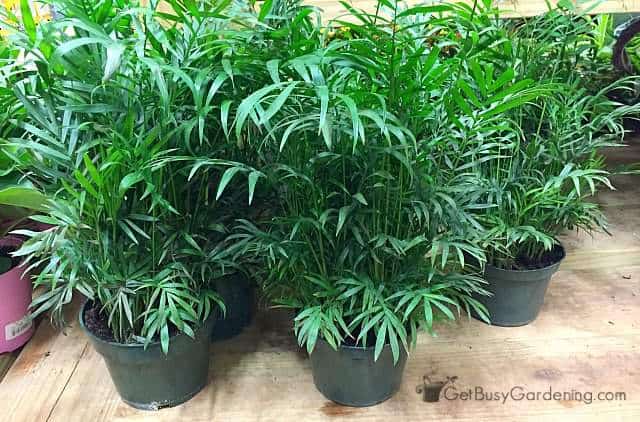
Light
Palm plants can easily adapt to low light conditions indoors. Most of them need bright, indirect light, and their leaves can burn in the direct sun.
They won’t survive in complete darkness though, so if there’s no sunlight in the room, you’ll definitely need to add a grow light.
If you put your palm plant outside during the summer, make sure to keep it in the shade so it doesn’t get sunburn.
Potting Soil
When it comes to the type of soil to use, palm plants aren’t super picky. But the best potting medium for them is a loose, porous mix, such as a combo of peat moss, leaf mold, and shredded bark.
You can also buy a fast draining mix that’s specifically made for them. Otherwise they will do just fine in a general purpose one.
If you tend to forget to water your plants, then you can add some peat moss and/or vermiculite into the soil to help it retain moisture longer.

Fertilizer
While they don’t really need to be fertilized, indoor palm plants will benefit from being fed as a part of your regular care routine.
However, they are very sensitive to chemical fertilizers, which can cause brown tips and margins, or easily burn the roots. So it’s best to use an organic option. My favorites are Jobe’s, Espoma, and Dr. Earth.
Whatever type you decide to use, be sure to only feed your plants during the spring and summer, and stop during the fall and winter to give them a rest.

Pest Control Tips
Spider mites are the most common pest that attack indoor palm plants. Keep the humidity level high around the foliage to fend them off. Houseplant scale and mealy bugs can also become a problem sometimes.
If you find any bugs, begin treating them immediately to prevent them from spreading. I recommend using organic neem oil, which is a natural pesticide.
Insecticidal soap also works well, or you can make your own by mixing 1 teaspoon of mild liquid soap with 1 liter of water.
Related Post: How To Get Rid Of Houseplant Bugs
Pruning
You can regularly trim back your indoor palm plants to keep them looking nice, or to maintain their size and shape. Spring is the best time to do maintenance pruning or to remove long, leggy stems.
It’s common for the lower leaves to turn yellow or brown with age, and you can cut off those fronds anytime of the year using regular pruning shears.
Brown tips and leaf edges are also very common. To trim those off, use a sharp pair of bonsai shears or micro-tip snips.
Troubleshooting Common Problems
It’s usually pretty easy to care for palm plants indoors. But sometimes your plant will start to have problems, and you’re not sure why. Below are the most common issues you might run into, with my tips for how to fix them:
Leaves Turning Brown Or Yellow
It’s normal for the lower, oldest fronds to turn yellow, then brown, and eventually die. So you can just prune those off as part of your regular maintenance routine.
However, if the newer, top leaves are turning brown and dying, then it’s usually caused by improper watering (too much or too little), bugs, or lack of humidity.
Let the soil dry 1-2″ deep before watering again, and check your plant for any signs of bugs. If it’s very dry in your home, try running a humidifier in the room or mist the foliage.
Brown Tips & Margins
One of the most common problems that indoor palm plants have is brown leaf margins and tips. This is usually caused by lack of water, dry air, chemical fertilizers, or pests.
Check to make sure you’re watering enough, and inspect the leaves for bugs. Use organic fertilizer rather than chemicals, and try to increase the humidity level around the plant.
For some species, brown tips and margins are just a normal part of their life cycle, so it’s not always something you can fix. If they bother you, simply trim them off to keep your plant looking its best.
Indoor Palm Tree Is Dying
There are several things that can cause indoor palm plants to die. The most common one is overwatering, but it could also be a lack of humidity, or inadequate lighting.
The soil should dry slightly between waterings, and never be completely bone dry or soggy.
Ensure your plant gets bright, indirect sunlight, and increase the humidity level if it has brown tips.
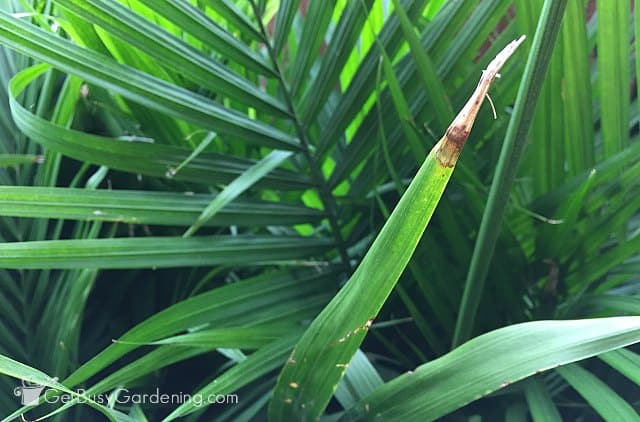
Indoor palm trees and plants are very low maintenance, and will thrive for years when you give them the proper care. Follow the tips in this guide for the best success.
If you want to learn all there is to know about maintaining healthy indoor plants, then you need my Houseplant Care eBook. It will show you everything you need to know about how to keep every plant in your home thriving. Download your copy now!
Share your indoor palm plant care tips and advice in the comments below.


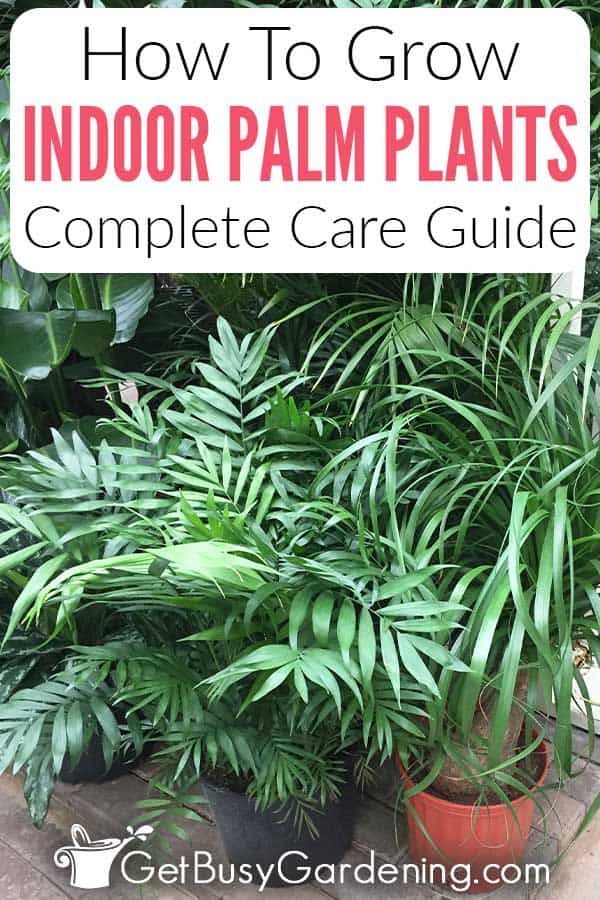
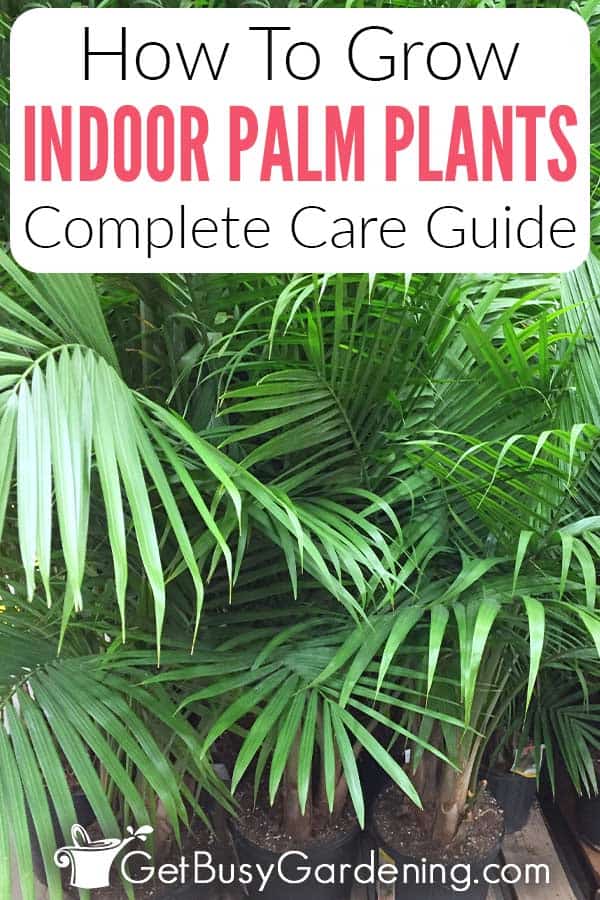
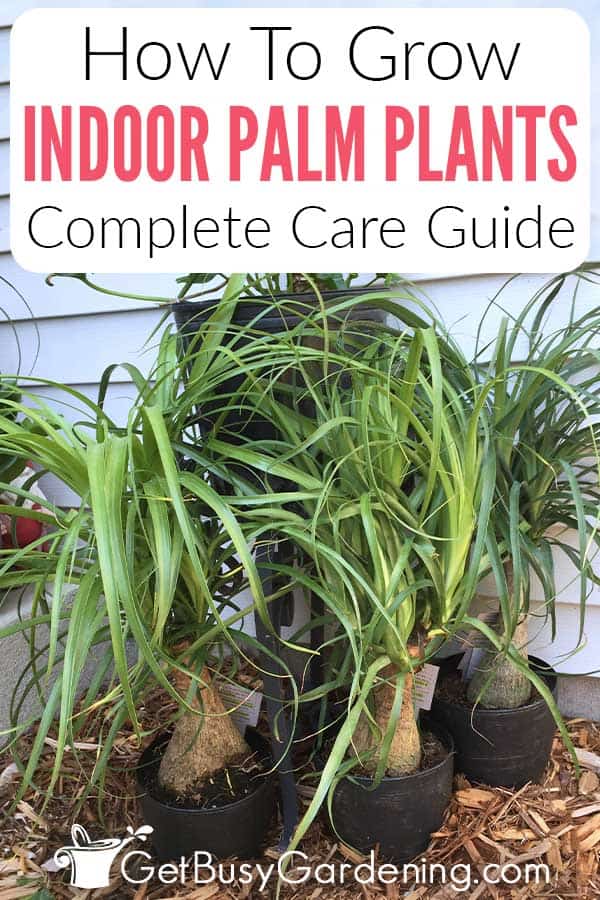
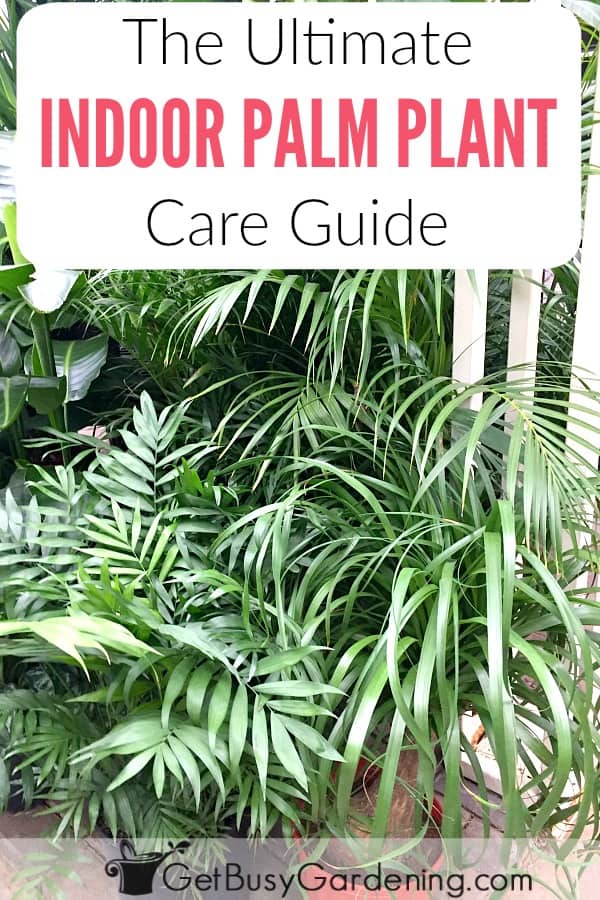
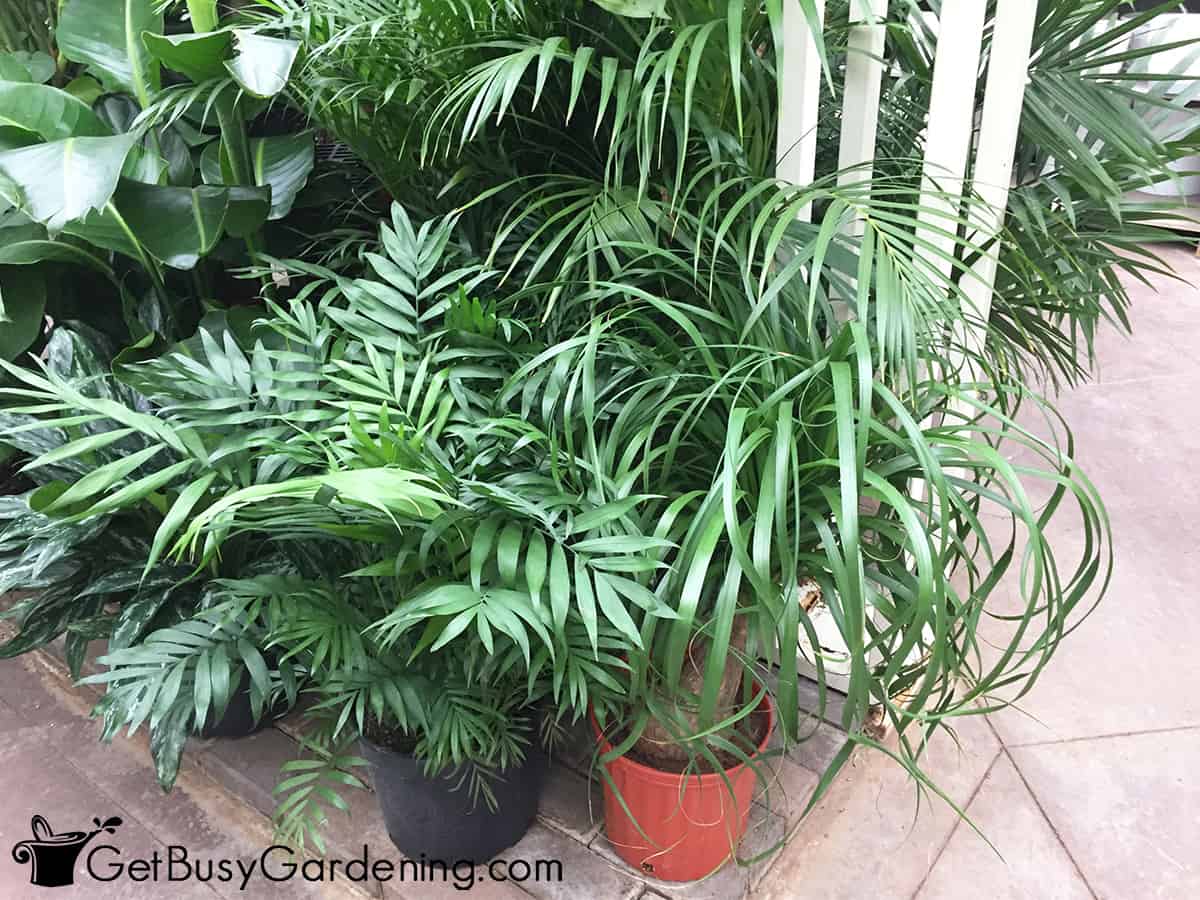



Dot Van Dyke says
I bought a indoor Palm tree at Costco about 3 months ago and it is doing really well.
However, I am seeing small light green sprouts coming out. Do I cut those off and let them be?
I have a photo if you would like to see what I am referring to.
Amy Andrychowicz says
The small light green sprouts could either be new palm leaves or flowers. I wouldn’t cut them off. You can share a photo on my Facebook page if you’d like, and I’ll take a look.
Arthur Pfeiffer says
Hi I bought a plam tree in Florida about 10 years ago I plam tree is still growing great I was just wondering what the little shoot that grows out of the side of the tree and has little branches and little balls on the branches . Thanks Artie
Amy Andrychowicz says
It sounds to me like your palm tree is flowering! That means you’re doing a great job caring for it. 🙂
Tassja Plummer says
Hi, the fronds on my (young) parlour palm keep laying flat at the base of the plant then die off. Any ideas? I bought it a couple of months ago & it’s just not doing well. All of my other palms are fine.
Amy Andrychowicz says
I would start by checking soil to make sure it’a not too wet or dry. When indoor palm plants fronds die back like that, it’s almost always a watering problem. The soil should be evenly moist, allow it to dry out about 1-2″ deep before giving it more. It should never feel wet or soggy, but also should never dry to the point where the soil is pulling away from the inside of the pot.
Susan says
Wondering what I can do with an indoor single palm stem plant that has gotten to be about 4 ft tall and is very scraggly looking?
Amy Andrychowicz says
Make sure you’re giving your palm plant the right amount of water (not too much or too little), then try giving it more light. They tend to get thing and scraggly when the room is too dark. Some varieties need more light than others though, so make sure you look up the exact requirements so you know how much to give yours.
Shmuel Wahli says
the palm tree has been steadily growing and now is generating a good supply of oil sticky substance on the leaves… is this a sign of good health as it grows or indicating a problem? thanks for the response.
Amy Andrychowicz says
Sticky stuff on indoor palm tree leaves usually indicates a pest problem. Take a close look at the leaves to see if you can spot any bugs, make sure to check underneath them and along the stems too. Here’s how to identify the most common types of houseplant bugs.
Bob Wright says
I have a baby palm is it safe to put a plastic
Bag over it to boost the humidity.
Amy Andrychowicz says
I wouldn’t recommend putting a plastic bag over your palm, as that will most likely cause it to eventually mold or rot. The best way to increase humidity is either by misting or running a humidifier nearby.
Jay R says
My palm tree sprouted and had a stem and 2 tiny leaves but just recently they started closing should I be worried?
Thank you
Amy Andrychowicz says
Humm… I’m not sure I understand your question. Are you saying your plam plant flowered?
Randal Grosser says
Hi there. This is my first palm plant. It’s Beautiful! but my kittens keep playing with and eating the ends off of the leaves. I have tried several forms of discouragement but they have not worked and I am left with shredded and chewed off ends on the leaves. Is it ok to trim the ends of the leaves?
Thank you so much.
Amy Andrychowicz says
Yep, I have a cat who loves chewing on the leaves of my palm plants too. You can prune the tips off, making your cuts at the same angle as the natural shape of the leaf so it looks better. I have found sour apple spray works great to keep cats from eating the leaves. I’ve never had it damage any of my plants, but it’s always best to test it on a few leaves before spraying the whole plant to make sure it’s ok. Here are more tips for keeping cats out of your houseplants.
Dianne says
my indoor palm plant has a new stem growing from soil that has little round knobs on it….do you have any idea what this is?
Amy Andrychowicz says
It sounds like your indoor palm plant may have the start of a scale infestation. Here’s an article that will help you make a positive ID and give you tips for how to get rid of it.
Dawn says
My indoor palm is 36” high. I have the lower 14” supported by wooden dowels on two sides. However, I need something more substantail as the palm is leaning. Ideas please……
Amy Andrychowicz says
Depending on what type of palm plant it is, you might be able to prune it back to get it to branch out more. Or it may need to be repotted into a larger container, that might help to stabilize it and give you more space to build a larger support for it. Check the pot to see if it’s root-bound before repotting it though. You don’t want to size it up unless it actually needs it. One other thing, since it’s leaning, it might need more light. You can move it to a brighter location, or add a grow light. That might help.
Sarah says
My palm plants have been in the same pots for years, and the soil has sunk down into the pot about three inches, leaving some roots exposed. I’m reading here they don’t like to be repotted. Do I just add soil or should I find some new bigger pots and take my chances on repotting?
Amy Andrychowicz says
If your palm plant is completely pot-bound, then it’s time for a new container. The way to tell is if roots are coming out of the bottom holes, the pot is becoming distorted, and/or the soil won’t hold any water (it just runs straight through). If it’s not pot-bound, you can just add more soil to the top to cover the exposed roots.
Don Weber says
I tried sending a photo, but apparently it won’t go. I have a palm that is around 38 years old. I believe originally their were 3-4 stalks, but during a move it didn’t do well. I’ve kept one alive and when it gets too tall I’ve made a cut and got the stalk to reroot. Now, for whatever reason the new leaves are not opening or very spindly. I see no bugs and only fertilize rarely. Suggestions or just old and call it a good life? It was part of a gift when our first child was born. Thx. Happy holidays
Amy Andrychowicz says
The move could be the reason the leaves won’t open. Most plants don’t like to be moved, and it can take a long time for them to recover from it. But it could also be caused by lack of light, improper watering, or because it’s pot-bound. Make sure it’s in a location with plenty of bright light, the soil isn’t soggy or completely dry, and that it hasn’t outgrown its pot. If it’s cold and dry indoors during the winter where you are, then try to keep it warm and maybe even mist it occasionally. Keep in mind that indoor palm plants are much slower to grow in the winter, so you might just want to maintain it until spring, and see what happens when the active growing season starts again.
Becky says
Hi! I just bought a full grown indoor palm plant for my new office which is absolutely beautiful. I have put it in a corner next to the window so it never gets direct sunlight, but should get plenty of indirect sunlight. I made the mistake of overwatering it once and the leaves started turning yellow quickly. I think I got that stopped OK. But now I’m just paranoid about killing it.
I purchased the terra-cotta spikes that you put wine bottles full of water into. I carefully put two of them in, one on each side of the plant, and they definitely are working OK. My question is, do I just keep those wine bottles filled up when they empty? This would not give any opportunity for the soil to dry out, but the the soil doesn’t ever really get sopping wet either. Or should I wait some time. Before filling the wine bottles again? If so, how do I know when it’s time to fill them again? I really don’t want to overwater or underwater the plant.
Thanks for your time!
Amy Andrychowicz says
With plant watering devices like that, it’s usually safe to keep them filled with water all the time. They are designed to prevent over or under watering. However, since your palm plant was already overwatered, I’d definitely check the soil every week or so to make sure it’s not staying too wet.
Stella says
My daughter had a palm tree which I brought home because her toddler was always getting into it. I noticed the soil didn’t look very healthy so I took the plant right out of the soil cleaned all the roots off and put it back into a clean pot of soil. I noticed that there are brown stems coming from the roots of each leaf do I snippet this off, hopefully get some green leaves. I’m so worried that I may not be able to revive this palm tree which I’m really sorry because it looked beautiful in the corner in family room. Also when I was putting it back into the pot with new soil, the plant toppled over and broke a couple of stems, so of course that doesn’t help the tree itself. I hope I will receive a response from you and perhaps as to what I might be doing wrong.
Thank you so very much.
Amy Andrychowicz says
Sorry to hear that your palm plant is not doing well. Unfortunately, they hate to be repotted, and can live in the same container for many years. So, the fact that the new fronds are brown after repotting it could mean that it’s suffering from transplant shock. If that’s the case, the only thing you can do is leave it alone, and it should recover in time. However, brown leaves could be caused by improper watering (either too much or too little), or fertilizer burn. Allow the soil to dry slightly between waterings, and make sure it’s never completely bone dry, or wet. Don’t fertilize it again until it recovers.
Vickie Swarringin says
Hi, I bought an indoor Palm tree for my huge family room, and I set it by my patio sliding glass doors because I thought it was supposed to be within 3-4 ft. of indirect sunlight. Now entire branches are brown and some of the long leaves on 2 others are starting to turn brown. Do you think it is getting TOO MUCH sunlight? I know it is draining well, because when I water it a little of the water comes out of the bottom of the planter (not a lot, maybe a couple of 3-4 tablespoons). I have never had a problem growing something indoors before, and I don’t want to kill this plant.. Please help with some advice. Thank you very much!
Amy Andrychowicz says
It certainly could be that your palm plant is getting sunburn through the window. However, if you live in cold climate, it could be suffering from cold air coming from the patio door (read more about that here). Brown leaves and tips can also be caused by lack of humidity, or not enough water. Another thing to check for is bugs. Take a close look at the leaves to make sure you don’t see any webbing or bugs on them. Oh, and since you just brought it home, and if you do live in a cold climate, did you wrap it up good before bringing it outside? If not, it could have gotten frozen, and that may be why the leaves are slowly dying. Best thing you can do is to check the location to make sure it’s not getting too hot or cold, and check for bugs. Then make sure it’s getting enough water, and that the soil is never bone dry. Hope this helps.
Kelly Perrotta says
Hello I have a white powdery substance on the underneath of the leaves what is this and how can I get rid of it
Amy Andrychowicz says
It sounds to me like your palm plant may have mealybugs. They look more like a white powdery substance or even cotton than bugs. Here’s how to ID them, and get rid of them… How To Get Rid Of Mealybugs On Your Houseplants, For Good!